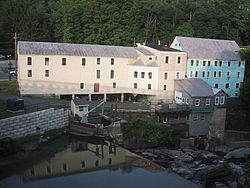Bethel, Vermont | |
|---|---|
Town | |
 Old mill buildings in Bethel, Vermont | |
 Location in Windsor County and the state of Vermont. | |
| Coordinates: 43°50′40″N 72°38′46″W / 43.84444°N 72.64611°W | |
| Country | United States |
| State | Vermont |
| County | Windsor |
| Chartered | 1779 (Vermont) |
| Communities |
|
| Area | |
• Total | 45.4 sq mi (117.7 km2) |
| • Land | 45.2 sq mi (117.0 km2) |
| • Water | 0.3 sq mi (0.7 km2) |
| Elevation | 573 ft (256 m) |
| Population (2020) | |
• Total | 1,942 |
| • Density | 43/sq mi (16/km2) |
| • Households | 817 |
| • Families | 548 |
| Time zone | UTC-5 (EST) |
| • Summer (DST) | UTC-4 (EDT) |
| ZIP code | 05032 |
| Area code | 802 |
| FIPS code | 50-05800[1] |
| GNIS feature ID | 1462043[2] |
| Website | bethelvt |
Bethel is a town in Windsor County, Vermont, United States. The population was 1,942 at the 2020 census.[3] The town includes the locations of Bethel village, Bethel-Gilead, East Bethel, Lilliesville, Lympus (formerly Olympus), and West Bethel. Bethel is best known for being the source of Bethel White granite which was used to build Washington Union Station and the National Museum of Natural History. Bethel was the first town created by the independent Republic of Vermont in 1779 and was named after the Biblical village of Bethel.
- ^ "U.S. Census website". United States Census Bureau. Retrieved January 31, 2008.
- ^ "US Board on Geographic Names". United States Geological Survey. October 25, 2007. Retrieved January 31, 2008.
- ^ "Census - Geography Profile: Bethel town, Windsor County, Vermont". United States Census Bureau. Retrieved December 28, 2021.